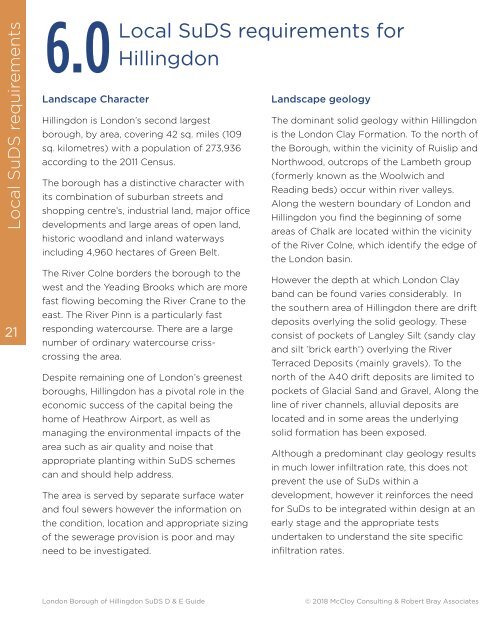Hillingdon SuDS Design & Evaluation Guide
Create successful ePaper yourself
Turn your PDF publications into a flip-book with our unique Google optimized e-Paper software.
Local <strong>SuDS</strong> requirements<br />
21<br />
6.0<br />
Landscape Character<br />
Local <strong>SuDS</strong> requirements for<br />
<strong>Hillingdon</strong><br />
<strong>Hillingdon</strong> is London’s second largest<br />
borough, by area, covering 42 sq. miles (109<br />
sq. kilometres) with a population of 273,936<br />
according to the 2011 Census.<br />
The borough has a distinctive character with<br />
its combination of suburban streets and<br />
shopping centre’s, industrial land, major office<br />
developments and large areas of open land,<br />
historic woodland and inland waterways<br />
including 4,960 hectares of Green Belt.<br />
The River Colne borders the borough to the<br />
west and the Yeading Brooks which are more<br />
fast flowing becoming the River Crane to the<br />
east. The River Pinn is a particularly fast<br />
responding watercourse. There are a large<br />
number of ordinary watercourse crisscrossing<br />
the area.<br />
Despite remaining one of London’s greenest<br />
boroughs, <strong>Hillingdon</strong> has a pivotal role in the<br />
economic success of the capital being the<br />
home of Heathrow Airport, as well as<br />
managing the environmental impacts of the<br />
area such as air quality and noise that<br />
appropriate planting within <strong>SuDS</strong> schemes<br />
can and should help address.<br />
The area is served by separate surface water<br />
and foul sewers however the information on<br />
the condition, location and appropriate sizing<br />
of the sewerage provision is poor and may<br />
need to be investigated.<br />
Landscape geology<br />
The dominant solid geology within <strong>Hillingdon</strong><br />
is the London Clay Formation. To the north of<br />
the Borough, within the vicinity of Ruislip and<br />
Northwood, outcrops of the Lambeth group<br />
(formerly known as the Woolwich and<br />
Reading beds) occur within river valleys.<br />
Along the western boundary of London and<br />
<strong>Hillingdon</strong> you find the beginning of some<br />
areas of Chalk are located within the vicinity<br />
of the River Colne, which identify the edge of<br />
the London basin.<br />
However the depth at which London Clay<br />
band can be found varies considerably. In<br />
the southern area of <strong>Hillingdon</strong> there are drift<br />
deposits overlying the solid geology. These<br />
consist of pockets of Langley Silt (sandy clay<br />
and silt ’brick earth‘) overlying the River<br />
Terraced Deposits (mainly gravels). To the<br />
north of the A40 drift deposits are limited to<br />
pockets of Glacial Sand and Gravel, Along the<br />
line of river channels, alluvial deposits are<br />
located and in some areas the underlying<br />
solid formation has been exposed.<br />
Although a predominant clay geology results<br />
in much lower infiltration rate, this does not<br />
prevent the use of SuDs within a<br />
development, however it reinforces the need<br />
for SuDs to be integrated within design at an<br />
early stage and the appropriate tests<br />
undertaken to understand the site specific<br />
infiltration rates.<br />
London Borough of <strong>Hillingdon</strong> <strong>SuDS</strong> D & E <strong>Guide</strong><br />
© 2018 McCloy Consulting & Robert Bray Associates


